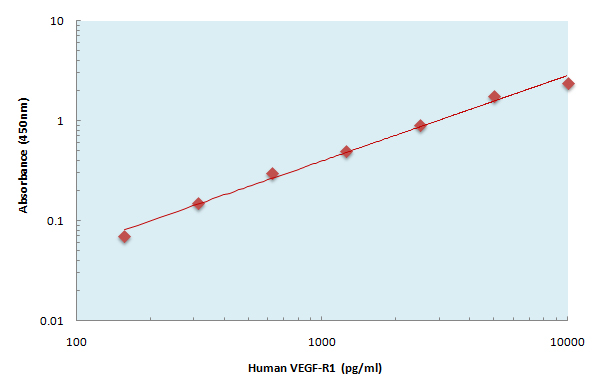Human VEGF-R1 ELISA Kit
- Catalog No.:KE1176
- Applications:ELISA
- Reactivity:Human
- Gene Name:
- FLT1
- Protein Name:
- Vascular endothelial growth factor receptor 1
- Human Gene Id:
- 2321
- Human Swiss Prot No:
- P17948
- Mouse Swiss Prot No:
- P35969
- Specificity:
- Sample Type for Cell Culture Supernates, Cell lysates, Tissue Lysates, Serum, EDTA Plasma, Heparin Plasma
- Storage Stability:
- 2-8°C/6 months
- Other Name:
- FLT1;FLT;FRT;VEGFR1;Vascular endothelial growth factor receptor 1;VEGFR-1;Fms-like tyrosine kinase 1;FLT-1;Tyrosine-protein kinase FRT;Tyrosine-protein kinase receptor FLT;FLT;Vascular permeability factor receptor
- Detection Method:
- Colorimetric
- Background:
- alternative products:Additional isoforms seem to exist,catalytic activity:ATP + a [protein]-L-tyrosine = ADP + a [protein]-L-tyrosine phosphate.,function:Receptor for VEGF, VEGFB and PGF. Has a tyrosine-protein kinase activity. The VEGF-kinase ligand/receptor signaling system plays a key role in vascular development and regulation of vascular permeability. Isoform SFlt1 may have an inhibitory role in angiogenesis.,similarity:Belongs to the protein kinase superfamily. Tyr protein kinase family.,similarity:Belongs to the protein kinase superfamily. Tyr protein kinase family. CSF-1/PDGF receptor subfamily.,similarity:Contains 1 protein kinase domain.,similarity:Contains 7 Ig-like C2-type (immunoglobulin-like) domains.,subunit:Interacts in vitro with various phosphotyrosine-binding proteins, including PLC-gammas, PTPN11, GRB2, CRK and NCK1.,tissue specificity:Mostly in normal lung, but also in placenta, liver, kidney, heart and brain tissues. Specifically expressed in most of the vascular endothelial cells, and also expressed in peripheral blood monocytes. It is not expressed in tumor cell lines. Isoform sFlt1 is strongly expressed in placenta.,
- Function:
- MAPKKK cascade, activation of MAPKK activity, angiogenesis, blood vessel development, patterning of blood vessels,response to hypoxia, morphogenesis of a branching structure, vasculature development, protein amino acid phosphorylation, phosphorus metabolic process, phosphate metabolic process, cell motion, regulation of muscle contraction, regulation of smooth muscle contraction, cell surface receptor linked signal transduction, enzyme linked receptor protein signaling pathway, transmembrane receptor protein tyrosine kinase signaling pathway, intracellular signaling cascade, protein kinase cascade, pattern specification process, female pregnancy, positive regulation of cell proliferation, positive regulation of signal transduction, positive regulation of cell communication, phosphorylation, cell migration, peptidyl-tyrosine phosphorylation, peptidyl-tyrosine modification, regulation of p
- Subcellular Location:
- [Isoform 1]: Cell membrane; Single-pass type I membrane protein. Endosome. Autophosphorylation promotes ubiquitination and endocytosis.; [Isoform 2]: Secreted .; [Isoform 3]: Secreted.; [Isoform 4]: Secreted.; [Isoform 5]: Cytoplasm .; [Isoform 6]: Cytoplasm .; [Isoform 7]: Cytoplasm .
- Expression:
- Detected in normal lung, but also in placenta, liver, kidney, heart and brain tissues. Specifically expressed in most of the vascular endothelial cells, and also expressed in peripheral blood monocytes. Isoform 2 is strongly expressed in placenta. Isoform 3 is expressed in corneal epithelial cells (at protein level). Isoform 3 is expressed in vascular smooth muscle cells (VSMC).
- June 19-2018
- WESTERN IMMUNOBLOTTING PROTOCOL
- June 19-2018
- IMMUNOHISTOCHEMISTRY-PARAFFIN PROTOCOL
- June 19-2018
- IMMUNOFLUORESCENCE PROTOCOL
- September 08-2020
- FLOW-CYTOMEYRT-PROTOCOL
- May 20-2022
- Cell-Based ELISA│解您多样本WB检测之困扰
- July 13-2018
- CELL-BASED-ELISA-PROTOCOL-FOR-ACETYL-PROTEIN
- July 13-2018
- CELL-BASED-ELISA-PROTOCOL-FOR-PHOSPHO-PROTEIN
- July 13-2018
- Antibody-FAQs
- Products Images

- The Human VEGF-R1 ELISA Kit allows for the detection and quantification of endogenous levels of natural and/or recombinant Human VEGF-R1 proteins within the range of 157-10000 pg/ml.



